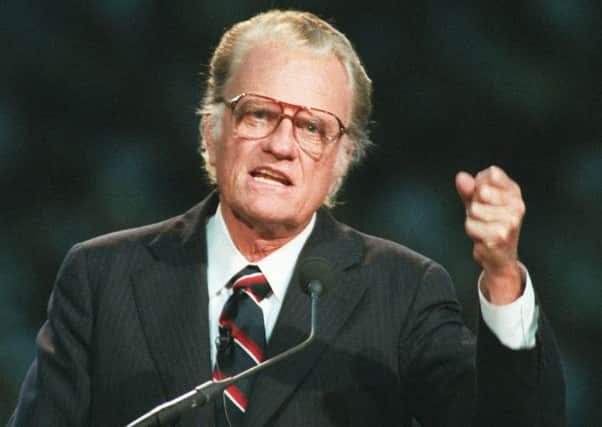Obituary: Rev Billy Graham, charismatic preacher who counselled US presidents


The Rev Billy Graham, the magnetic preacher who became a singular force in post-war American religious life, a confidant of presidents and the most widely heard Christian evangelist in history, has died at the age of 99.
More than anyone else, Graham – dubbed “America’s Pastor” – built evangelicalism into a force that rivaled liberal Protestantism and Roman Catholicism in the US. His leadership summits and crusades in more than 185 countries and territories forged powerful global links among conservative Christians and threw a lifeline to believers in the Communist bloc.
Advertisement
Hide AdAdvertisement
Hide AdA tall, striking man with thick, swept-back hair, stark blue eyes and a firm jaw, Graham was a commanding presence in the pulpit, with a powerful baritone voice. “The Bible says,” was his catchphrase. His unquestioning belief in Scripture turned the Gospel into a “rapier” in his hands, he said.
Graham reached multitudes around the globe through public appearances and his pioneering use of prime-time telecasts, network radio, daily newspaper columns, evangelistic films and satellite TV hook-ups. By his final crusade in 2005 in New York City, he had preached in person to more than 210 million people worldwide. No evangelist is expected to have his level of influence again.
Graham was a counsellor to US presidents of both parties from Dwight Eisenhower to George W Bush. In 1983, President Ronald Reagan gave him the Presidential Medal of Freedom, America’s highest civilian honor. When the Billy Graham Museum and Library was dedicated in 2007 in Charlotte, North Carolina, George HW Bush, Jimmy Carter and Bill Clinton attended.
“When he prays with you in the Oval Office or upstairs in the White House, you feel he’s praying for you, not the president,” Clinton said at the ceremony.
Born November 7, 1918 on his family’s dairy farm near Charlotte, Graham came from a fundamentalist background that expected true Bible-believers to steer clear of Christians with even the most minor differences over Scripture. But he came to reject that view for a more ecumenical approach.
Ordained a Southern Baptist, he later joined a then-emerging movement called New Evangelicalism that abandoned the narrowness of fundamentalism. Fundamentalists broke with him when he agreed to work with more liberal Christians in the 1950s.
Graham’s path began taking shape at 16, when the farmboy committed himself to Christ at a tent revival. After high school, he enrolled at the fundamentalist Bob Jones College but found the school stifling and transferred to Florida Bible Institute in Tampa. There, he practiced sermonising in a swamp, preaching to birds and alligators before tryouts with small churches.
Graham went on to study at Wheaton College, a prominent Christian liberal arts school in Illinois, where he met fellow student Ruth Bell, who had been raised in China where her father had been a Presbyterian medical missionary.
Advertisement
Hide AdAdvertisement
Hide AdThe two married in 1943, and he planned to become an army chaplain. But he fell seriously ill, and by the time he recovered and could start the chaplain training programme, the Second World War was nearly over. Instead, he took a job organising meetings in the US and Europe with Youth for Christ, a group he helped found.
A 1949 Los Angeles revival turned Graham into evangelism’s rising star. Held in a tent dubbed the “Canvas Cathedral,” the gathering had been drawing adequate but not spectacular crowds until one night when reporters and photographers descended.
When Graham asked them why, a reporter said that publisher William Randolph Hearst had ordered his papers to hype Graham. The preacher said he never found out why.
Over the next decade, crusades in England and New York catapulted him to international celebrity. His 12-week London campaign in 1954 defied expectations, drawing more than 2 million people.
Three years later, he held a crusade in New York’s Madison Square Garden that was so popular it was extended from six to 16 weeks, capped off with a rally in Times Square that packed Broadway with more than 100,000 people.
As the civil rights movement took shape, Graham was no social activist and never joined marches, which led prominent Christians such as theologian Reinhold Niebuhr to condemn him as too moderate.
Still, Graham ended racially segregated seating at his Southern crusades in 1953, a year before the Supreme Court’s school integration ruling, and long refused to visit South Africa while its white regime insisted on racially segregated meetings.
Graham more robustly took on the cause of anti-communism, making preaching against the atheist regime part of his sermons for years.
Advertisement
Hide AdAdvertisement
Hide AdAs America’s most famous religious leader, he golfed with statesmen and entertainers and dined with royalty. Graham’s relationships with US presidents became a source of pride for conservative Christians who were often caricatured as backward.
He was on the road for months at a time, leaving Ruth at their mountainside home in Montreat to raise their five children: Franklin, Virginia (“Gigi”), Anne, Ruth and Nelson (“Ned”).
In his later years, Graham visited Communist Eastern Europe and increasingly appealed for world peace. He opened a 1983 convention of evangelists from 140 nations by urging the elimination of nuclear and biological weapons. He told audiences in Czechoslovakia that “we must do all we can to preserve life and avoid war,” although he opposed unilateral disarmament. In 1982, he went to Moscow to preach and attend a conference on world peace.
Along with many other honours, Graham received the $1 million Templeton Prize for Progress in Religion in 1982 and the Congressional Gold Medal in 1996.
RACHEL ZOLL & JONATHAN DREW